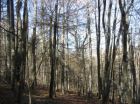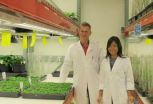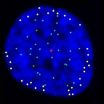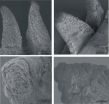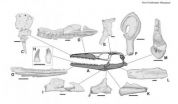Pair of proteins gets brain cells into shape
2012-12-20
(Press-News.org) This press release is available in German.
The study conducted by Prof. Frank Bradke's team provides indications on brain development and about the causes of diseases of the nervous system. The results have now been published in "Neuron".
Under the microscope, the brain appears as a network of intricate beauty comprising billions of nerve cells (the so-called "neurons") linked together. This network is engaged in a constant process of sharing information. The signals are transmitted from neuron to neuron through fine ramifications of the cell body. However, to acquire this typical structure, young nerve cells have first to go through a shape transformation. "Young neurons have a rather inconspicuous form. They tend to be round and are reminiscent of cherries," comments Frank Bradke, group leader at the DZNE in Bonn. "At this stage, the neuron is much like an island. It is insulated and does not have any direct contact with other cells."
Consequently, nerve cells have to go through a phase of change while they are still in the early stages of their development. To date, little was known about how the cells master this transformation, which is so important for their function. It is essential for the brain's development that its neurons develop contacts to a multitude of other cells. The initial step of this process is that tiny extensions, the so-called "neurites" protrude out of the cell body. The study conducted by the researchers in Bonn and their colleagues sheds light on this process.
A dynamic duo gets its grip on the cell's corset
Investigating mouse brain cells, the neuroscientists were able to identify the three key players involved in the shape change: the cell's cytoskeleton, which consists of specific proteins that give the cell its form and stability, as well as the two proteins named "ADF" and "cofilin." "We were able to show that these two proteins do have a significant impact on cell structure," explains Dr. Kevin Flynn, a postdoc researcher in Bradke's team and first author of the report published in "Neuron". "Much like scissors they cut through the support corset of the cell in the proper location. Neurites can subsequently develop through these gaps."
For this to occur several processes have to work hand in hand: along its perimeter, the neuron receives its stability mainly through a network of actin filaments, string shaped protein molecules. The proteins ADF and cofilin can alter this structure by dissolving the actin filaments and enabling fragments resulting from this process to be carried away. As a result, other components of the cytoskeleton – the microtubules – are able to come to action. The microtubule migrate through the newly opened gap and form a new cell protuberance.
Impact on the development of the brain
In their study, the researchers demonstrated the significance of the two proteins in nerve cell development. In certain mice, the production of ADF and cofilin was virtually halted. As a result the brains of newborn animals had severe abnormalities. Analysis of their brain cells indicated that they had failed to develop any neurites.
"Our study shows that the proteins ADF and cofilin, and their interaction with actin filaments, are key factors for brain development," comments Bradke. However, the development of neurites is also of relevance in other contexts. For instance, nerve cells have to regrow their connections after an injury. In addition, a number of diseases and malformations of the nervous system are linked to underdeveloped neurites. "We now have a better understanding of the molecular processes that are involved in this important process."
###
Original Publication:
"ADF/cofilin-mediated Actin Retrograde Flow Directs Neurite Formation in the Developing Brain," Kevin C. Flynn, Farida Hellal, Dorothee Neukirchen, Sonja Jacobs, Sabina Tahirovic, Sebastian Dupraz, Sina Stern, Boyan K. Garvalov, Christine Gurniak, Alisa Shaw, Liane Meyn, Roland Wedlich-Söldner, James R. Bamburg, J. Victor Small, Walter Witke, Frank Bradke, Neuron.
Online at: http://www.cell.com/neuron/abstract/S0896-6273%2812%2900897-5. END
ELSE PRESS RELEASES FROM THIS DATE:
2012-12-20
A researcher with the Faculty of Medicine & Dentistry and the Mazankowski Alberta Heart Institute is looking closely at a molecule linked to aortic aneurysms in the abdomen, and her findings could lead to a treatment to reduce swelling of the aortic artery, which would be a life-saving treatment.
Zamaneh Kassiri, a professor in the Department of Physiology, and Ratnadeep Basu, a PhD trainee in Kassiri's lab, have been looking at the role of a protein called TIMP3 in the vessels. Their most recent findings, published in The Journal of Biological Chemistry, shows that animal ...
2012-12-20
URBANA – Due to the introduction of exotic pests and pathogens, tree species are being eliminated one by one from forest ecosystems. In some cases, scientists can observe immediately how their loss affects the environment, whereas in other cases, creative puzzle solving and analysis reveal unexpected repercussions. In the case of the loss of the hemlock tree, University of Illinois landscape and ecosystem ecologist Jennifer Fraterrigo uncovered a surprising benefit to hardwood species.
Throughout much of the eastern United States, a pest called the hemlock woolly adelgid ...
2012-12-20
Best known for its ability to transform simmering pots of sugared fruit into marmalades and jams, pectin is a major constituent of plant cell walls and the middle lamella, the sticky layer that glues neighboring plant cells together. Pectin imparts strength and elasticity to the plant and forms a protective barrier against the environment. Several different kinds of pectic compounds combine to form pectin. The relative proportion of each of these depends on the plant species, location within the plant, and environment. Pectic compounds decorated with β-1,4-galactan ...
2012-12-20
LA JOLLA, CA----For humans to grow and to replace and heal damaged tissues, the body's cells must continually reproduce, a process known as "cell division," by which one cell becomes two, two become four, and so on. A key question of biomedical research is how chromosomes, which are duplicated during cell division so that each daughter cell receives an exact copy of a person's genome, are arranged during this process.
Now, scientists at the Salk Institute have discovered a new characteristic of human cell division that may help explain how our DNA is organized in the ...
2012-12-20
Food enthusiasts interested in sustainable farm practices may soon have a new meat alternative: insects. Beetle larvae (called mealworms) farms produce more edible protein than traditional farms for chicken, pork, beef or milk, for the same amount of land used, according to research published December 19 in the open-access journal PLOS ONE by Dennis Oonincx and colleagues from the University of Wageningen, Netherlands.
The researchers compared the environmental impact of meat production on a mealworm farm to traditional animal farms using three parameters: Land usage, ...
2012-12-20
Prehistoric farming communities in Europe constructed water wells out of oak timbers, revealing that these first farmers were skilled carpenters long before metal was discovered or used for tools. The research published December 19 in the open access journal PLOS ONE by Willy Tegel and colleagues from the University of Freiburg, Germany, contradicts the common belief that metal tools were required to make complex wooden structures.
The wooden water wells discovered in eastern Germany are over 7000 years old, and suggest that these early farmers had unexpectedly refined ...
2012-12-20
Like sheets of paper marked with perforated lines, gecko tails have unique structural marks that help them sever their tails to make a quick getaway. Though voluntarily shedding a body part in this manner is a well-known phenomenon, research published December 19 in the open access journal PLOS ONE reveals aspects of the process that may have applications for structural engineers making similar, quickly detachable structures.
VIDEO:
Bridging structures are not present between ...
2012-12-20
Humpback whales might be expected to take their food seriously given their enormous size, but a new study shows that they may multi-task as they eat, singing mating or breeding songs as they forage in their Antarctic feeding grounds. The research, published December 19 in the open-access journal PLOS ONE by Alison Stimpert from the Naval Postgraduate School and colleagues, sheds new light on the whales' singing habits in different seasons, which are still a mystery.
Whales sing most frequently during the breeding season but are known to sing on other occasions, such as ...
2012-12-20
A new mosasaur species discovered in Hungary is the first known example of this group of scaled reptiles to have lived in freshwater river environments similar to modern freshwater dolphins, according to research published December 19 in the open-access journal PLOS ONE by Laszlo Makadi from the Hungarian Natural History Museum, Hungary and colleagues from the University of Alberta, Canada and MTA-ELTE Lendület Dinosaur Research Group, Hungary.
The species lived about 84 million years ago, the largest specimens reached about 20 feet in length, and belongs to a family ...
2012-12-20
LA JOLLA, Calif., December 19, 2012 – Amyotrophic lateral sclerosis (ALS), also known as Lou Gehrig's disease, is untreatable and fatal. Nerve cells in the spinal cord die, eventually taking away a person's ability to move or even breathe. A consortium of ALS researchers at multiple institutions, including Sanford-Burnham Medical Research Institute, Brigham and Women's Hospital, and the University of Massachusetts Medical School, tested transplanted neural stem cells as a treatment for the disease. In 11 independent studies, they found that transplanting neural stem cells ...
LAST 30 PRESS RELEASES:
[Press-News.org] Pair of proteins gets brain cells into shape
